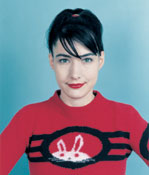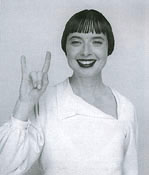 |
  |
 |
  |
 |
 |
| |

Read Bjork's2001 interview with Juergen Teller from the index archives. |

|
 |

Kathleen Hanna discusses writing and making music in this interview from 2000 with Laurie Weeks. |
|
 |
|
 |
|
|
 |

Isabella Rossellini spoke with Peter Halley in this 1999 interview. |
|
 |
|
|
 |
 |
|
Alexander McQueen's 2003 interview with Bjork. |
|
 |
|
|
 |
|

|
Tess Giberson, 2002
WITH ZOË WOLFF
PHOTOGRAPHED BY LEETA HARDING |

If you haven't heard of Tess Giberson, that's because she prefers to keep a low profile, sticking close to her sewing machine and steering clear of fashion-world hoopla.
Still, people, and you might say the right people, are taking notice of her unique folk couture.
We caught up with the young designer at her studio and home in New York's Meatpacking District.
ZOE: Your new fall collection felt very optimistic to me. All the whites and florals have a hopeful quality.
TESS: Right after September 11, I started pulling out photos from my childhood Ñ pictures of me with my two sisters. It gave me the inspiration for this collection. I put them up on my wall and they made me happy. It really helped me feel that things were going to be okay.
ZOE: Does your childhood influence the way that you design?
TESS: I used to draw clothing all the time. My parents are both artists, so we were always making things. My dad is a glassblower. He had a huge studio with a woodworking shop and a potter's wheel right behind our house. He taught us how to blow glass. My mom made all of my clothes. She'd crochet and knit our sweaters and hats.
ZOE: That sounds so nurturing.
TESS: But I didn't know that I wanted to design clothing until I was a freshman at RISD. I went around to all the different studios in order to choose my major. One day I went into the apparel studio, and I just knew. I loved the way it smelled, I loved the machines, I loved the fabric all over the place. [laughs]
ZOE: You responded to the physicality of making clothes.
TESS: Yeah. I learned pattern making and draping. One semester's all about tailoring, then you spend one semester doing nothing but knitting.
ZOE: Did your mom make the children's clothing tacked up on the wall here? They look well worn.
TESS: Yeah. My sister recently sent me that little jumper and some hats I used to wear.
ZOE: They remind me of the current Marc Jacobs collection with the Ô70s-love-child feeling. The mustard-colored corduroy jumper is so cute.
TESS: That's one of my favorites. The inside is violet with red flowers. My mother liked to include special details that you wouldn't see from the outside. My new collection is about collaging memories of my childhood and of my mom, and translating that into my aesthetic.
ZOE: Would you say that it has a sort of Ô70s vibe?
TESS: I don't think in those terms. There's only so much you can do if you're referencing previous eras. I think much more about the fabric and the emotional feeling I'm trying to create.
ZOE: Have you always felt an emotional relationship to clothes?
TESS: I love the psychological side of clothing. You can feel vulnerable or comfortable, depending on what you're wearing. There are always things I can put on that I know will automatically make me feel good. And if you're not comfortable, you'll carry yourself in a different way.
ZOE: At the recent runway shows, I noticed a lot of designers embracing an arts-and-craftsy look. It seems like a movement is developing which is all about really intricate, handmade clothes.
TESS: Yeah, I noticed that too, and I don't know how long it will last. This is really the only way I know how to do things. My mom placed such a value on handwork.
ZOE: Tell me more about your family. It sounds like your parents were hippies.
TESS: My parents got married in the late Ô60s and decided to move up to New Hampshire. They had a lot of friends who had also moved there from big cities. It was an ideal place to raise children and to grow up. Everyone made something, whether they were painters or potters or weavers.
ZOE: Did you lead a totally organic life?
TESS: Until I entered first grade, my mom made everything. When I was really young, she used to grind the grains and bake bread. We'd get eggs and milk from friends who had farms. In the summer and fall we'd make jam, can tomatoes, and freeze basil and string beans. My parents even made tofu.
ZOE: The patterns and embroidery in the new collection seem to be based on things you would find in nature. It's interesting, considering how you grew up.
TESS: We lived at the end of a dirt road, surrounded by forty acres and an orchard. That's all part of my vocabulary. When you're out in the woods, you really lose yourself in your imagination.
ZOE: Do you personally make every single garment you sell?
TESS: I do handwork on each piece. I used to make everything from beginning to end, but now I have two sewers who help me. I make my patterns and give them to the sewers. Then they give me the base back and I embellish.
ZOE: It must be really time-consuming. Every piece looks like it would take hours and hours to make.
TESS: Yeah, but sewing is something that I enjoy. I'm not interested in making drawings for other people to produce. I always want to have my hand in it.
ZOE: Have you ever made quilts?
TESS: No, but I would love to. Right now I'm focusing on the clothing because it's just getting started. But I'm open to working in different formats later on.
ZOE: So much of your work is based around the way you build up the fabric.
TESS: I'm always trying to find different ways to do stitches and layer fabric. Last year, I made crests, which I placed on a turtleneck and on a jacket. The turtleneck really had a sense of armor Ñ the crest fit right over the sternum. I was working with the idea of protection.
ZOE: But the mark looks so delicate. It makes me think of hair or dental floss.
TESS: I let the piece basically create itself. With these pants, for example, I started with a simple pair of trousers as my base. Then I cut strips of fabric, layered them in a crosshatch pattern, and wove them all together.
ZOE: Your fabrics seem very traditional, almost like Brooks Brothers oxford shirts.
TESS: I like high-quality fabrics that feel good on the skin. I start out with a simple fabric that I can distort and compose with. I love working with the textiles Ð pulling them apart and rearranging them.
ZOE: It seems obvious that each collection has evolved from the last.
TESS: I usually work with something from the previous collection and just push it to see where it goes. I want to make things that are special. That's why a lot of my detailing is subtle Ñ I don't want to just make trendy pieces that get put in the back of the closet.
ZOE: In New York your clothes are only at Barneys and Seven, the Orchard Street showcase for young designers.
TESS: And I have two stores in Tokyo and one store in Hong Kong. I'm planning to add one or two stores in London and Paris, too. But I don't want to grow so much that my line becomes just another clothing business. Then your pieces just end up on sale someplace, and that's kind of heartbreaking. It's wonderful being sold in Seven because they have a great audience Ñ very knowledgeable people shop there. It's so personal Ñ John and Joseph, the owners, give me a lot of feedback from the customers.
ZOE: If you saw a woman walking down the street wearing something you'd made, would you say anything?
TESS: Probably not. [laughs] But last summer I met this woman who bought the first thing I ever sold at Seven, a white sleeveless dress with hand stitching throughout. I ended up becoming pretty good friends with her. When that dress sold, it gave me the momentum to continue working. She described how she saw the dress and really wanted it, even though it was expensive for her. Now sometimes she'll just put it up on her wall.
ZOE: What do you think she responded to in particular?
TESS: I think the dress has a timelessness to it. For that collection, everything was white and ethereal.
ZOE: I could see you doing really well in Belgium. Belgian designers are so focused on detail and construction.
TESS: Yeah, they definitely have more of an appreciation for the traditional structure of a garment. I'm interested in sewing the way it should be done, without taking shortcuts. It's important to me that the pieces are well made. With all the handwork that I do, I want the clothes to last.
ZOE: What's it like working with Barneys?
TESS: When they first contacted me, I was hesitant. In the beginning I was really set on only having one-of-a-kind pieces. But then I met the buyer, Julie Gilhart. She was so wonderful. By the time she left my studio, I was ready to fill an order for her.
ZOE: Is it strange dealing with a corporate entity like that?
TESS: The first time I went up there and saw my pieces in the store, it was really weird. I was used to only seeing them in my studio. Coming across them at Barneys is like checking yourself out in public. But I'm learning to step back. The clothes have to go out of my studio at some point.
ZOE: So many young designers have a shtick Ð or a very calculated plan.
TESS: I don't believe in shticks. People always want a sound bite, something easy that can sell the clothes. It drives me crazy. I'm convinced that if it's good, solid work, you don't need a gimmick to sell it.
|
|
 |
|
|
 |

©
index magazine
Tess Giberson by Leeta Harding, 2002 |
|
 |
|
 |
 |
|
Copyright © 2008 index Magazine and index Worldwide. All rights reserved.
Site Design: Teddy Blanks. All photos by index photographers: Leeta Harding,
Richard Kern, David Ortega, Ryan McGinley, Terry Richardson, and Juergen Teller |
| |